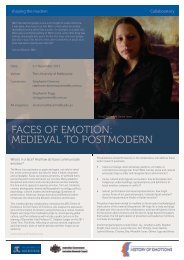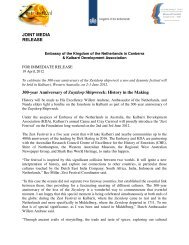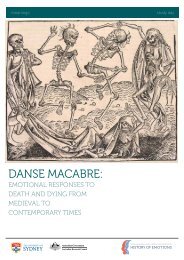Download our K-12 education pack - ARC Centre of Excellence for ...
Download our K-12 education pack - ARC Centre of Excellence for ...
Download our K-12 education pack - ARC Centre of Excellence for ...
You also want an ePaper? Increase the reach of your titles
YUMPU automatically turns print PDFs into web optimized ePapers that Google loves.
stories <strong>for</strong> teachers & students 2013<br />
Supporting Res<strong>our</strong>ces<br />
South Africa, Far from Home<br />
stories by winthrop pr<strong>of</strong>essor susan broomhall<br />
Stones <strong>of</strong> Love in Deep Time:<br />
Ancient rocks, old emotions,<br />
new business opportunities<br />
The lands that are now Australia and South Africa share a longer<br />
history than many know and the discoveries in the earth beneath<br />
us have revealed intense emotions in <strong>our</strong> societies.<br />
The oldest recorded life <strong>for</strong>ms on <strong>our</strong> planet are found in<br />
<strong>our</strong> two lands. The Pilbara region <strong>of</strong> WA is host to microbes<br />
known as stromatolites some 3.2 billion years old. Stromatolites<br />
2.5 billion years old are found in the Transvaal Supergroup <strong>of</strong><br />
South Africa. Shark Bay’s living marine stromatolites are a mere<br />
2000-3000 years old but their scientific importance was a key<br />
part <strong>of</strong> the region being declared a World Heritage Area. Until<br />
those at Shark Bay were discovered in the 1950s, scientists only<br />
knew about stromatolites as fossils from ancient times. At Shark<br />
Bay they can study them as life <strong>for</strong>ms doing what stromatolites<br />
were also doing billions <strong>of</strong> years ago when they dominated life in<br />
the seas.<br />
Joined in deep time, South Africa and Australia also have<br />
geological features in common, not least a bounty <strong>of</strong> diamonds,<br />
gold and iron ore buried below the surface. Our shared history <strong>of</strong><br />
British colonial control has resulted in both <strong>our</strong> diamond-mining<br />
regions being named Kimberley. But why How are emotions<br />
mixed up in this story<br />
Diamonds were discovered in the North Cape Province <strong>of</strong> South<br />
Africa in 1866, when Erasmus Jacobs saw a bright pebble on the<br />
banks <strong>of</strong> the Orange River at his father’s farm. This turned out to<br />
be a 21.25 carat diamond. Three years later, a much larger 83.50<br />
carat diamond, known as the ‘Star <strong>of</strong> South Africa’, was found on<br />
a nearby farm, Vooruitzigt (‘outlook’ in English) which belonged<br />
to the De Beer brothers, Diederik Arnoldus and Johannes<br />
Nicholas. This discovery sparked a frenzy. Within just a month,<br />
over 800 claims had been made and two to three thousand men<br />
were busy at work cutting in to the hills. The area quickly<br />
became known as ‘New Rush’. The little hill soon became a<br />
mine. Today it is known as the ‘Big Hole’, 463 metres wide and<br />
covering a surface <strong>of</strong> some 17 hectares. Within less than ten<br />
years, the town was the second largest in South Africa. Everyone<br />
had a dream <strong>of</strong> riches to be found.<br />
Colonial politics soon were caught up in the mix, with Boer<br />
(Afrikaner farmers) and British political leaders arguing over<br />
who should control the newly wealthy region, and what name it<br />
should be given. The Secretary <strong>of</strong> State <strong>for</strong> the Colonies, John<br />
Wodehouse, Lord Kimberley, writing from London, insisted that<br />
the lands had to receive (what he decided were) ‘decent and<br />
intelligible names.’ In particular, he wrote scornfully that he did<br />
not want them ‘in any way connected with such a vulgarism as<br />
New Rush and as <strong>for</strong> the Dutch name, Vooruitzigt … he could<br />
neither spell nor pronounce it.’ The Colonial Secretary, J.B.<br />
Currey, decided the best thing to do was to name it after<br />
Kimberley himself. The mine became known internationally as<br />
the Kimberley Mine.<br />
The company De Beers was founded in 1888, by Cecil Rhodes,<br />
now famous <strong>for</strong> his <strong>education</strong>al philanthropy worldwide. He had<br />
started <strong>of</strong>f renting water to the miners during the early diamond<br />
rush and soon made enough pr<strong>of</strong>it to buy land claims and start<br />
his own mining company. The ‘De Beer’ name was an emotional<br />
one. The brothers themselves had no connection to the firm,<br />
but the brothers’ farm had been the site <strong>of</strong> the biggest diamond<br />
found at that time. The farm was one <strong>of</strong> those that Rhodes<br />
and his business partner Barney Barnato purchased. It was a<br />
name that represented hope. Un<strong>for</strong>tunately Barnato and<br />
Rhodes quarrelled over the business: Rhodes won out and<br />
Barnato mysteriously disappeared over the side <strong>of</strong> a ship<br />
sailing <strong>for</strong> London.<br />
How is it that diamonds have become the ‘stone <strong>of</strong> love’, those<br />
most commonly chosen <strong>for</strong> engagement rings Diamonds had<br />
been a fav<strong>our</strong>ite <strong>of</strong> the nobility <strong>for</strong> engagement rings since<br />
Archduke Maximilian <strong>of</strong> Austria had given one as a betrothal gift<br />
to Mary <strong>of</strong> Burgundy in 1477. However, the new diamond<br />
discoveries in South Africa’s Kimberley increased global<br />
supplies, and opened up to many more people the possibility <strong>of</strong><br />
purchasing such a stone. During the twentieth century, diamond<br />
FAR FROM HOME: ADVENTURES, TREKS, EXILES & MIGRATION<br />
27












